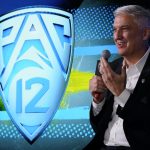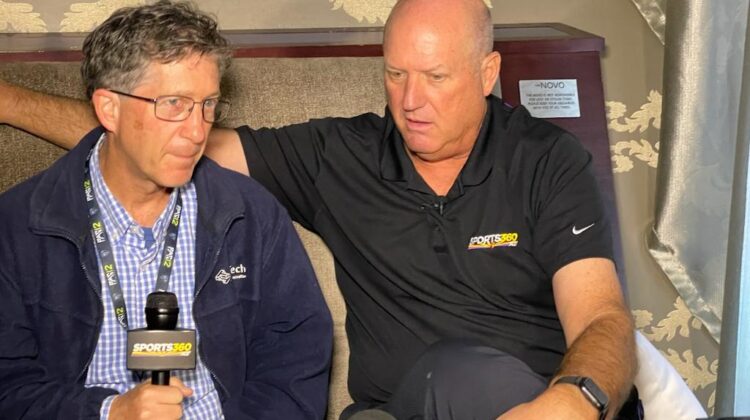Why don’t the TV networks understand that Washington State is in the Seattle metro market — much more than Oregon. — @bigpurple
The method by which media companies assign valuations to football programs has been the source of much discussion and debate over the past eight weeks.
It doesn’t carry a simple explanation, however.
A decade ago, the prime driver of media value was, in fact, market size — revenue potential was based on pay-TV (cable) subscribers within a school’s footprint.
By adding Colorado, for example, the Pac-12’s valuation increased because its partners (e.g., Comcast) wanted the Denver market.
Market size still matters in this round of realignment, but not to the extent it once did. Now, ratings (audience) also matter.
Three essential revenue streams for linear media companies are advertising sales, monthly subscribers (cable) and retransmission fees, which are the payments local providers send to broadcasting networks for the programming. And those fees are based on audience.
Fox and Disney, which owns ESPN and ABC, want their conference partners to provide big games and popular teams in order to generate ratings. But they also want markets for the monthly subscriptions.
They want it all.
Within this space, Washington State is an interesting case. The Cougars produce viewership numbers that exceed what might be expected of a program with a small local media market. (Spokane is the 66th-largest market in the country, according to Nielsen data.)
Why would WSU’s audience outperform its local market?
One reason is the Apple Cup, which typically moves the ratings needle. (The Friday afternoon slot on Thanksgiving weekend, with little competition, is partly responsible for that.) But WSU’s alumni base in Seattle, the nation’s No. 12 media market, undoubtedly contributes to the ratings success, as well.
When the media consultants working for the Pac-12 or Big 12 create valuation models for each school, they consider both market size and audience. All those Washington State fans watching in Seattle are, in fact, contributing to the Cougars’ media valuation.
The problem for WSU? Its overall valuation doesn’t come close to clearing the Big Ten’s bar; nor would it be accretive enough for the Big 12 when other factors — geography — are considered.
If you transplanted WSU’s campus into one of the Four Corners states and assigned the football program the very same valuation it currently carries, the Cougars would warrant consideration.
But the combination of remote geography and what we would call B-level valuation are significant impediments.
If the Pac-12 dissolves — and that possibility exists until a new media rights deal is signed — then WSU is probably bound for the Mountain West.
Pac-12 football operations chief Merton Hanks spoke about the desire to get down to eight conference games during an appearance on the Bald Faced Truth radio show — but that partners were needed to make it financially worthwhile. Is the relationship with the Big 12 too fractured to make a deal for that purpose? — @beal_zach
At this point, it’s difficult to envision a partnership. The Big 12 is waiting to pounce on the remains of the Pac-12 in the event Oregon, Washington, Stanford and Cal join the Big Ten.
Really, there is one option for a non-conference partner: The ACC, which plays eight conference games.
The scheduling arrangement would provide any media partner with markets on both coasts and satisfy both collections of presidents, who see institutional alignment.
But some ACC schools have filled their non-conference spots in future years and might be forced to buy their way out of contracts with Group of Five or FCS opponents.
The common assumption is that the Pac-12 Networks are either going away or will be managed by ESPN moving forward. However, we know that Amazon and Apple have production partners: Apple is using the MLB Network to produce Friday Night Baseball, for example. Is it more likely the conference just keeps production in-house and uses Amazon or Apple to distribute the feeds versus just selling everything off? — @David May
The Pac-12 Networks’ production capacity could very well factor into the next media rights agreement and, therefore, the conference’s survival.
It could simply rent the facility and equipment to Apple or Amazon, which would pay for the right to distribute the content on their streaming platforms.
Also possible: Apple or Amazon buys everything, then hires the Pac-12 Networks staff to handle the production piece.
Either way, the result is the same:
One of the digital giants would own the most valuable piece — the content — and handle the distribution in the same manner as traditional rights-holders like ESPN and Fox.
Chances that Amazon or Apple get Tier 1 rights to Pac-12 content? — @GoCougs7
For Tier 1 rights, the likelihood seems slim.
The Pac-12 needs its best games to have the widest audience possible, and that won’t happen on Amazon or Apple. Not enough sports fans consume content through those platforms. (A decade from now, the situation could be different.)
But it’s not hard to envision the Pac-12 partnering with one of them for rights to secondary inventory.
We wondered about the conference selling a package of games to Amazon for broadcast on Thursday night, after the NFL game.
After all, its target audience is on the West Coast (Seattle, Portland and the Bay Area), and the cross-promotional opportunities would be considerable.
However, that arrangement would require the Pac-12 game to start after 8 p.m. on a weeknight — probably too late.
What would it take to keep USC from leaving the Pac-12? Could you save the conference from more schools defecting by creating unequal revenue sharing? — @namthien_v
USC is gone, and not even the promise of an unequal-share business model would prompt a reversal.
There has been plenty of chatter on social media, and a few reports across legitimate media, about the Pac-12 considering unequal shares as a means of keeping Oregon and Washington happy in the reconfigured conference.
The Hotline has yet to confirm that plan is being seriously considered at the presidential level, at least thus far.
It’s a suboptimal solution.
Should the conference consider unequal shares of the postseason revenue based on College Football Playoff and NCAA success?
Absolutely. But that’s not nearly as disruptive to intra-conference alignment as splitting the media revenue in uneven fashion.
What are the chances USC opposes additional westward expansion from the Big Ten so it can have an advantage for recruits in California over Oregon, Washington, Stanford, and Cal? — @schroater_mark
The chances are at least 6,734 percent.
One of the primary competitive benefits to leaving Oregon and Washington behind in the Pac-12 was the adverse impact it would have on their recruiting efforts in Southern California.
The Trojans won’t give that up within the Big Ten boardroom without a fight.
Given the caveat that all other Notre Dame sports are part of the ACC, would the Irish join that conference instead of the Big Ten? — @RickStubblefie1
It’s not unreasonable to consider that end game, but everything about Notre Dame football works with the Big Ten, starting with the massive alumni base in Chicago.
The school’s agreement with the ACC complicates a potential move into the Big Ten, but not to the extent some believe.
Because the Irish are not a full-time ACC member, they only receive a partial share of the annual revenue distributions.
In other words, their financial penalty for breaking the grant-of-rights contract would be limited — and easily covered by a few years of Big Ten revenue.
When the College Football Playoff expands and Notre Dame remains an Independent, shouldn’t the Irish be required to play 13 regular-season games, with 10 Power Five opponents in the mix? — Jon Joseph
If college football were run like a professional sport, yes — the playing field should be level.
Then again, if college football were run like a professional sport, one school would not have the same voting power as an entire conference.
And yet here we are. With regard to the CFP, Notre Dame’s vote carries the same weight in the boardroom as the SEC’s.
The Pac-12 turned down Oklahoma and Oklahoma State in 2011. It declined to raid the Big 12 last year. What makes you think they’ll get it right this time? — @travisgaley
I’m not at all sure they will get it right, which is one reason the Hotline views Pac-12 survival as a mere 4.5-point favorite over Pac-12 extinction.
(The other reason is the Big Ten threat.)
If the decisions were left to conference executives and the athletic directors, our line would be closer to a touchdown.
But insert the presidents into the calculation, and the likelihood of a wrong turn increases.
If Arizona wins six this season, Washington wins nine and USC wins 11, who is the Pac-12 Coach of the Year? — @MattZemek
It wouldn’t be Lincoln Riley — you can count on that. USC’s coach only wins the award when there are no other justifiable choices. (Pete Carroll won it outright once and shared it twice.)
In the scenario laid out here, Jedd Fisch probably wins over Kalen DeBoer because of the turnaround orchestrated in Tucson and because everyone recognizes Washington was better than a four-win team last season.
There are always politics involved when coaches vote on anything.
And Fisch, in addition to the merits of his case — if the Wildcats were to win six — would be a comfortable pick for anyone hesitant to prop up a rival.
Support the Hotline: Receive three months of unlimited access for just 99 cents. Yep, that’s 99 cents for 90 days, with the option to cancel anytime. Details are here, and thanks for your support.
*** Send suggestions, comments and tips (confidentiality guaranteed) to pac12hotline@bayareanewsgroup.com or call 408-920-5716
*** Follow me on Twitter: @WilnerHotline
*** Pac-12 Hotline is not endorsed or sponsored by the Pac-12 Conference, and the views expressed herein do not necessarily reflect the views of the Conference.
Related posts:
 Pac-12 football: The Hotline’s picks for individual awards and the all-conference teams
Pac-12 football: The Hotline’s picks for individual awards and the all-conference teams
 Hotline mailbag: Pac-12 leadership, Amazon’s purchasing options, timing for media rights, Utah’s future, WSU’s staff turnover and more
Hotline mailbag: Pac-12 leadership, Amazon’s purchasing options, timing for media rights, Utah’s future, WSU’s staff turnover and more
 Pac-12 football outlook: Our projections for the 2023 conference race
Pac-12 football outlook: Our projections for the 2023 conference race

(AP Photo/Marcio Jose Sanchez)
Hotline mailbag: Impact of the Comcast mess, options for Oregon and UW, Kliavkoff’s leadership, Pac-12 expansion options and more

